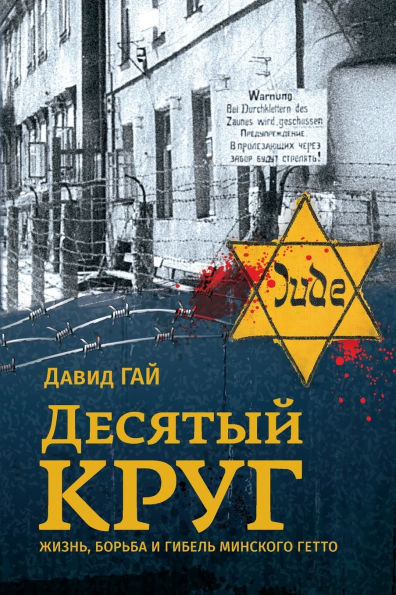The documentary "The Tenth Circle" tells the story of life, struggle and death in the Minsk ghetto - one of the largest in the Soviet Union and Europe during the Second World War.
This book is more than relevant today, as anti-Semitism walks freely on the planet. It includes the voices of those who were privileged to experience the ghetto during the last war. Literally and figuratively. The author managed to meet most of these people of very old age and recorded their stories.
The uniqueness of this book is also in the fact that it tells in detail how the Minsk ghetto was fought, how the underground operated, how hundreds of prisoners went to the Belarusian forests and joined partisan units.
Time has no power over memory. In this story, the memory of the ghetto is divided into many dozens of human testimonies - direct, ingenuous and terrible. In the ghettos, as in the concentration camps, the Nazis sought to reduce people to such a state that they could hardly distinguish between right and wrong. According to their plan, man would turn into an animal, his soul would almost lose the ability to show normal feelings. But even in such a situation, many remained human, proving the greatness of the human spirit.
Remembrance-sorrow, remembrance-hope, remembrance-warning - this is what the story is filled with, which, according to the author, will be perceived by the reader's heart.
Документальная повесть Десятый круг рассказывает о жизни, борьбе и гибели Минского гетто - одного из крупнейших на территории Советского Союза и Европы в годы Второй мировой войны.
Эта книга более чем актуальна и сегодня, когда антисемитизм свободно гуляет по планете. Она вобрала в себя голоса тех, кому выпала доля в минувшую войну пережить гетто. Пережить в прямом и переносном смысле. С большинством этих людей весьма преклонного возраста автору удалось встретиться и записать их рассказы.
Уникальность этой книги ещё и в том, что в ней подробно рассказывается о том, как Минское гетто боролось, как действовало подполье, как сотни узников уходили в белорусские леса и пополняли партизанские отряды.
Время не властно над памятью. В этой повести память о гетто расщепилась на многие десятки человеческих свидетельств - прямых, бесхитростных и страшных. В гетто, как и в концлагерях, нацисты стремились довести людей до такого состояния, чтобы они едва могли различать добро и зло. Человек, по их замыслу, превращался в животное, душа его должна была почти утратить способность проявлять нормальные чувства. Но и в такой ситуации многие оставались людьми, доказывая величие человеческого духа.
Память-скорбь, память-надежда, память-предостережение - вот чем наполнена повесть, которая, автор верит, будет воспринята читательским сердцем.
The documentary "The Tenth Circle" tells the story of life, struggle and death in the Minsk ghetto - one of the largest in the Soviet Union and Europe during the Second World War.
This book is more than relevant today, as anti-Semitism walks freely on the planet. It includes the voices of those who were privileged to experience the ghetto during the last war. Literally and figuratively. The author managed to meet most of these people of very old age and recorded their stories.
The uniqueness of this book is also in the fact that it tells in detail how the Minsk ghetto was fought, how the underground operated, how hundreds of prisoners went to the Belarusian forests and joined partisan units.
Time has no power over memory. In this story, the memory of the ghetto is divided into many dozens of human testimonies - direct, ingenuous and terrible. In the ghettos, as in the concentration camps, the Nazis sought to reduce people to such a state that they could hardly distinguish between right and wrong. According to their plan, man would turn into an animal, his soul would almost lose the ability to show normal feelings. But even in such a situation, many remained human, proving the greatness of the human spirit.
Remembrance-sorrow, remembrance-hope, remembrance-warning - this is what the story is filled with, which, according to the author, will be perceived by the reader's heart.
Документальная повесть Десятый круг рассказывает о жизни, борьбе и гибели Минского гетто - одного из крупнейших на территории Советского Союза и Европы в годы Второй мировой войны.
Эта книга более чем актуальна и сегодня, когда антисемитизм свободно гуляет по планете. Она вобрала в себя голоса тех, кому выпала доля в минувшую войну пережить гетто. Пережить в прямом и переносном смысле. С большинством этих людей весьма преклонного возраста автору удалось встретиться и записать их рассказы.
Уникальность этой книги ещё и в том, что в ней подробно рассказывается о том, как Минское гетто боролось, как действовало подполье, как сотни узников уходили в белорусские леса и пополняли партизанские отряды.
Время не властно над памятью. В этой повести память о гетто расщепилась на многие десятки человеческих свидетельств - прямых, бесхитростных и страшных. В гетто, как и в концлагерях, нацисты стремились довести людей до такого состояния, чтобы они едва могли различать добро и зло. Человек, по их замыслу, превращался в животное, душа его должна была почти утратить способность проявлять нормальные чувства. Но и в такой ситуации многие оставались людьми, доказывая величие человеческого духа.
Память-скорбь, память-надежда, память-предостережение - вот чем наполнена повесть, которая, автор верит, будет воспринята читательским сердцем.

The Tenth Circle
214
The Tenth Circle
214Paperback

Product Details
| ISBN-13: | 9781960533821 |
|---|---|
| Publisher: | M-Graphics Pub. |
| Publication date: | 05/12/2025 |
| Pages: | 214 |
| Product dimensions: | 5.50(w) x 8.25(h) x 0.58(d) |
| Language: | Russian |
